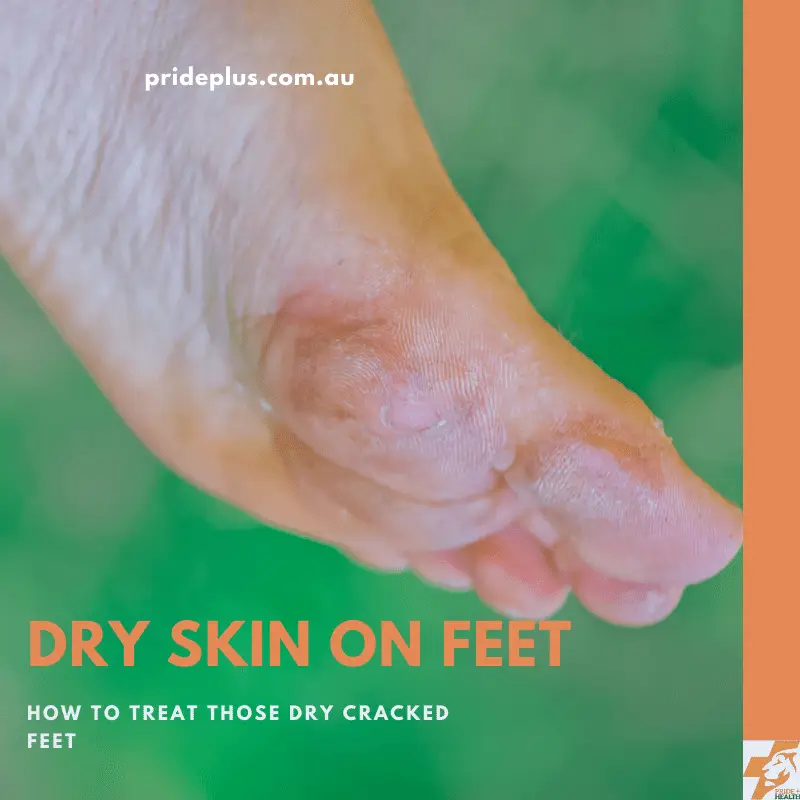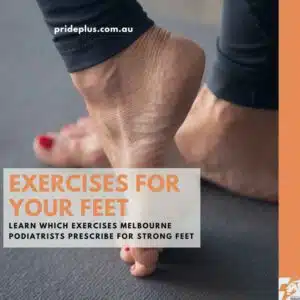How To Treat Dry Skin On Feet
Dry skin on feet is something that many of us battle all year round. Here we’ll give some background and then 3 steps to treat your feet.
In this guide you’ll learn about why we get dry skin and then my 3 tips to fix them:
- Moisturise, but not with what you might expect
- Wash, replace your soap with…
- And Socks, but not just any old pair
There are those of us who suffer more and summer time as we tend to wear thongs and sandals. And then there are some who get dry feet worse in the wintertime. This is often due to spending more time with just moccasins on around the house.
Dry skin on feet can also be related to medications.
And having dry skin on your feet is certainly something that happens more as we get older as ability to sweat reduces. You see sweat is super important when it comes to keeping your skin soft, supple and really nicely moisturised.
One of the main reasons for that is in our sweat we produce natural moisturising factors. These are acids that we secrete onto our skin. They include urea, salicylic acid, hyaluronic acid and lactic acid which help bind with the top surface layer of skin, the epidermis, and keep it from drying out.
So if we’ve sweat less, we secrete less acid.
While we’re talking acids on the skin, we also do some things to reduce those acids every day. Standard soaps are harsh and alkaline (the opposite of acidic) which dry skin on feet.
It’s important that we donate those acids back into the skin because it will help keep your feet soft and supple. Our skin should be acidic and ideally has a pH of 5.5.
So my three things that you need to do if you have dry skin on your feet
Dry Skin On Feet: Step 1
Moisturise, but I’m not talking about sorbolene.
I’m talking about using a moisturiser that has the natural acids that your skin needs.
As we get older or with certain medical conditions, we need to use higher levels of acids in our moisturiser.
For most of us we can use light, easily absorbed moisturisers to treat our dry feet. Products such as QV or Alphakeri that donate those natural acids back into our dry skin.
If we’ve got really dry skin either and we don’t produce those natural acids then we need to go to stronger moisturisers. These strong foot creams and balms have much higher concentrations of natural acids but they do tend to have a greasier type feel in comparison.
Dry Skin On Feet: Step 2
This one also relates to the natural acids on our skin.
Earlier I mentioned how harsh soaps are alkaline. Dermatologists have known for a long time that soap is bad for your skin. For any of us who have ever gone to a dermatologist for almost any skin condition will know this treatment. Every eczema sufferer out there, can I get an amen?
Switch from soap to a soap free wash.
If you can make this switch without heading to that trip to the dermatologist, you could save yourself a few hundred dollars and a couple of months wait.
Utilising a soap free wash that has those natural acids in it already and also has a pH level the same of the skin makes a big difference. When you use a soap free wash (again QV and Alphakeri make solid products in this space) the level of acidity stays the same as the skin. A pH of 5.5 means that you’re not washing away your natural acids and you’re not raising the alkalinity of your skin.
Even going soap free with just water (pH 7.0) can dry your skin out too. When you use a soap free wash your skin is not being forced to work harder than it needs to on a day to day basis and you’re able to keep soft supple skin year round.
Some people who use a soap free wash for their dry feet can even skip the first step.
It can be that effective that you don’t need to moisturise or apply lotions to your feet at all.
Dry Skin On Feet: Step 3
The next step that we need to do to make sure that we treat our dry skin on our feet is to, where possible, have a close layer protecting our skin.
I’m talking socks, sockettes or stockings.
Our bodies love being held, nurtured and some comfortable well fitting and clean socks will make a huge difference. Now I’m not advocating for the socks and sandals brigade.
Wearing socks where possible, practical and comfortable will help prevent dry skin.
Absolutely, there are many times when going sock-free in certain shoes and sandals is the best thing. For comfort, confidence and appearance being sock free in some sandals is ok. But if we are purely sock free in sandals all of the time we’re inviting dry skin on feet to get worse.
We do love sandals. Check out our best summer sandals for women and the best sandals for men.
And it’s not just our feet that love socks, our shoes do too!
Wearing clean socks and washing them daily means we remove the excess bacteria and fungus from our feet (via our socks). When we go barefoot these pathogens get absorbed into our shoes or sandals. This can lead to smelly feet, smelly shoes and full blown tinea pedis colonisation (a nasty fungal infection).
Wrapping Up
There are few conditions that dry skin on feet will always be more difficult to manage. Diabetes, people who’ve been long term smokers or drinkers, medications and advancing age are all factors.
There’s many people who start off with dry skin which in turn leads to hard skin, then cracks and fissures all over the feet and heels.
Being armed with some safe and recommended treatments from podiatrists and dermatologists is a great way to make sure you can keep your feet neat. Prevent and manage your own dry skin on feet with these tips.
If you need some personal guidance with the dry skin on your feet. Maybe your dry skin gets sore, gets hard and callused or you already have smelly feet that can leave us feeling embarrassed.
Come to see the experts.
Our podiatrists are available all across Melbourne in both the CBD, Pascoe Vale, Emerald and Monbulk.
We’re kind, compassionate and non-judgemental – hey, I’ve had smelly feet in the past from dry skin!
We know how to work with you to treat your dry skin and prevent it from coming back.
You can book in online for our clinics or call.
Take care of your dry skin, take care of your feet, and they’ll take you on your next adventure!
About the author
I’ve been a podiatrist working in Melbourne for over 10 years.
I’ve worked with people from a diverse backgrounds in very diverse settings. From aged care, sub-elite athletes, high risk foot and in general practice.
Teaching podiatry to students, and supporting my clients towards their successes are the two reasons I keep coming back to talk feet. Again and again.
The author does not receive a commission for products listed on this page.
Common Questions We Get In Clinic
Yes it can. If you have diabetes, are a smoker or concerned you could have poor blood flow you should have this assessed promptly. Podiatrists can complete a very quick, non-invasive test called and “absolute toe pressure” which will identify what your blood flow is like. Treating dry skin when you have poor blood flow is even more important as any bacterial infection or cuts on the skin can take even longer to heal. Some skin conditions might not heal at all.
When washing, bathing, or even soaking our feet using warm water helps us comfortably clear away the build up of dead skin, bacteria, fungus and grime. If the water is too hot we can shock the skin and it will dry out more. If the water is too cold we sometimes wash too little. Find a warm, comfortable temperature to bathe your feet, use a soap free wash and you’re on track.
A rough pumice stone can gently remove some dead skin cells. But be careful. You should not press too hard or be too abrasive. They are also breeding grounds for fungus and bacteria so if you are going to take the risk, replace them regularly and never share them with another person.
Calluses or hard skin can be present with or without dry skin. They’re usually associated more with friction and pressure and it’s best to see a podiatrist to remove them safely. Some calluses on the sole of the foot can be left as is for a long time and others on the toes can get really sore and form corns. See an expert podiatrist if you have any calluses with or without dry skin please.
Personally the Alphakeri creams are my favourite, both the soap free wash and the moisturiser. I find that the wash gets a nice lather and the moisturiser keeps my feet supple. But everyone is different! There’s plenty of love for the QV foot creams, the NS8 creams and the Walker’s Urea 15 cream. Start with one of these treatments and find out what your feet love the most.
This one is complex, you can learn more about diabetes and feet here but it relates to a combination of changes to nerves, blood vessels, medications and our endocrine (secretion) system. It’s not as simple as just a lack of blood or lack of moisture on the foot. Sweat glands and oil glands are also often effected in people with diabetes.
Cotton socks are a great start. Natural fibres like bamboo socks, merino wool and cotton are all very breathable. Some technical synthetic blends also provide good airflow and remove excess moisture from the skin. Start with natural fibres and experiment from there.
GPs like your local doctor are often a great first port of call for many different problems. In Australia we’re lucky to also have access to podiatrists who are the best people to see for treatment of foot problems. Podiatrists are considered primary care clinicians so are trained to both diagnose and then commence treatments.
If you suffer from common skin conditions such as psoriasis, eczema or allergies then you’ve probably already started your journey to take care of your dry skin. The advice provided here is ultimately general in nature but will be useful for those these conditions on either foot.




